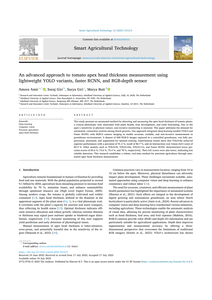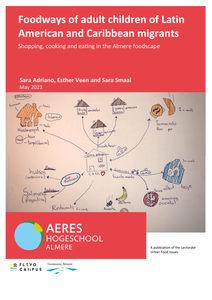In a multi-sensory environment, supported with embedded computer technology, the system can capture and interpret what the users are doing and assist or collaborate with the users in real-time. Such an environment should be aware of users intentions, tasks and feelings, and allow people to interact with the environment in a natural way: by moving, pointing and gesturing. In this paper we propose an architecture for such a smart environment consisting of three modules.
DOCUMENT
This study presents an automated method for detecting and measuring the apex head thickness of tomato plants, a critical phenotypic trait associated with plant health, fruit development, and yield forecasting. Due to the apex's sensitivity to physical contact, non-invasive monitoring is essential. This paper addresses the demand for automated, contactless systems among Dutch growers. Our approach integrates deep learning models (YOLO and Faster RCNN) with RGB-D camera imaging to enable accurate, scalable, and non-invasive measurement in greenhouse environments. A dataset of 600 RGB-D images captured in a controlled greenhouse, was fully preprocessed, annotated, and augmented for optimal training. Experimental results show that YOLOv8n achieved superior performance with a precision of 91.2 %, recall of 86.7 %, and an Intersection over Union (IoU) score of 89.4 %. Other models, such as YOLOv9t, YOLOv10n, YOLOv11n, and Faster RCNN, demonstrated lower precision scores of 83.6 %, 74.6 %, 75.4 %, and 78 %, respectively. Their IoU scores were also lower, indicating less reliable detection. This research establishes a robust, real-time method for precision agriculture through automated apex head thickness measurement.
DOCUMENT

The security of online assessments is a major concern due to widespread cheating. One common form of cheating is impersonation, where students invite unauthorized persons to take assessments on their behalf. Several techniques exist to handle impersonation. Some researchers recommend use of integrity policy, but communicating the policy effectively to the students is a challenge. Others propose authentication methods like, password and fingerprint; they offer initial authentication but are vulnerable thereafter. Face recognition offers post-login authentication but necessitates additional hardware. Keystroke Dynamics (KD) has been used to provide post-login authentication without any additional hardware, but its use is limited to subjective assessment. In this work, we address impersonation in assessments with Multiple Choice Questions (MCQ). Our approach combines two key strategies: reinforcement of integrity policy for prevention, and keystroke-based random authentication for detection of impersonation. To the best of our knowledge, it is the first attempt to use keystroke dynamics for post-login authentication in the context of MCQ. We improve an online quiz tool for the data collection suited to our needs and use feature engineering to address the challenge of high-dimensional keystroke datasets. Using machine learning classifiers, we identify the best-performing model for authenticating the students. The results indicate that the highest accuracy (83%) is achieved by the Isolation Forest classifier. Furthermore, to validate the results, the approach is applied to Carnegie Mellon University (CMU) benchmark dataset, thereby achieving an improved accuracy of 94%. Though we also used mouse dynamics for authentication, but its subpar performance leads us to not consider it for our approach.
DOCUMENT

In recent years, a step change has been seen in the rate of adoption of Industry 4.0 technologies by manufacturers and industrial organizations alike. This article discusses the current state of the art in the adoption of Industry 4.0 technologies within the construction industry. Increasing complexity in onsite construction projects coupled with the need for higher productivity is leading to increased interest in the potential use of Industry 4.0 technologies. This article discusses the relevance of the following key Industry 4.0 technologies to construction: data analytics and artificial intelligence, robotics and automation, building information management, sensors and wearables, digital twin, and industrial connectivity. Industrial connectivity is a key aspect as it ensures that all Industry 4.0 technologies are interconnected allowing the full benefits to be realized. This article also presents a research agenda for the adoption of Industry 4.0 technologies within the construction sector, a three-phase use of intelligent assets from the point of manufacture up to after build, and a four-staged R&D process for the implementation of smart wearables in a digital enhanced construction site.
DOCUMENT

The research sets out to explore what adult children of migrants consider to be their eating culture and food identity. We do so by looking at how they shop, cook, and eat on a daily basis and what foods they feel connected to. A secondary goal of this research is to understand how important sustainable food is for this group. For this report, we invited adult children of migrants, who grew up in Almere to share their stories. Being born in the Netherlands with parents who were born abroad – in our case Latin-America and the Caribbean – children of migrants grow up in two different food environments simultaneously. Outside the home, they are surrounded by a Dutch food environment, while the eating patterns in and around their household or wider family setting may reflect the backgrounds of their parents.
DOCUMENT

Background: Children with difficulties in listening and understanding speech despite normal peripheral hearing, can be diagnosed with the diagnosis Auditory Processing Disorder (A). However, there are doubts about the validity of this diagnosis. The aim of this study was to examine the relation between the listening difficulties of children between 8 and 12 years with suspected A and the attention, working memory, nonverbal intelligence and communication abilities of these children.Material and methods: In this case-control study we examined 10 children who reported listening difficulties in spite of normal peripheral hearing (3 referred by speech-language pathologist in the Northern Netherlands, 6 by an audiological center in the Southern Netherlands and one by parental concern) and 21 typically developing children (recruitment through word of mouth and by the website Taalexpert.nl), ages 8;0 to 12;0 years. The parents of all children completed three questionnaires about history, behavioral symptoms of ADHD, and communication skills (Children’s Communication Checklist). Teachers of the children completed the Children’s Auditory Processing Performance Scale (CHAPPS). Children were assessed for auditory processing abilities (speech-in-noise, filtered speech, binaural fusion, dichotic listening), nonverbal intelligence (Raven’s Coloured Progressive Matrices), and working memory (Clinical Evaluation of Language Fundamentals). Auditory and visual attention was studied with four behavioral tests of the WAFF battery of the Vienna Test System (Schuhfried).Results: Preliminary analysis shows no differences between groups on the auditory processing tests and nonverbal intelligence quotient. Children in the experimental group have poorer communication performance (parent report), poorer listening skills (teacher report), and poorer working memory and attention skills (behavioral tests).Conclusions: The results of this study showed that there is a difference between children with listening complaints and typically developing children, but that the problems are not specific to the auditory modality. There seems to be no evidence for the validity of an auditory deficit.
DOCUMENT

Background: Patient education, home-based exercise therapy, and advice on returning to normal activities are established physiotherapeutic treatment options for patients with nonspecific low back pain (LBP). However, the effectiveness of physiotherapy interventions on health-related outcomes largely depends on patient self-management and adherence to exercise and physical activity recommendations. e-Exercise LBP is a recently developed stratified blended care intervention comprising a smartphone app integrated with face-to-face physiotherapy treatment. Following the promising effects of web-based applications on patients’ self-management skills and adherence to exercise and physical activity recommendations, it is hypothesized that e-Exercise LBP will improve patients’ physical functioning. Objective: This study aims to investigate the short-term (3 months) effectiveness of stratified blended physiotherapy (e-Exercise LBP) on physical functioning in comparison with face-to-face physiotherapy in patients with nonspecific LBP. Methods The study design was a multicenter cluster randomized controlled trial with intention-to-treat analysis. Patients with nonspecific LBP aged ≥18 years were asked to participate in the study. The patients were treated with either stratified blended physiotherapy or face-to-face physiotherapy. Both interventions were conducted according to the Dutch physiotherapy guidelines for nonspecific LBP. Blended physiotherapy was stratified according to the patients’ risk of developing persistent LBP using the Keele STarT Back Screening Tool. The primary outcome was physical functioning (Oswestry Disability Index, range 0-100). Secondary outcomes included pain intensity, fear-avoidance beliefs, and self-reported adherence. Measurements were taken at baseline and at the 3-month follow-up. Results: Both the stratified blended physiotherapy group (104/208, 50%) and the face-to-face physiotherapy group (104/208, 50%) had improved clinically relevant and statistically significant physical functioning; however, there was no statistically significant or clinically relevant between-group difference (mean difference −1.96, 95% CI −4.47 to 0.55). For the secondary outcomes, stratified blended physiotherapy showed statistically significant between-group differences in fear-avoidance beliefs and self-reported adherence. In patients with a high risk of developing persistent LBP (13/208, 6.3%), stratified blended physiotherapy showed statistically significant between-group differences in physical functioning (mean difference −16.39, 95% CI −27.98 to −4.79) and several secondary outcomes. Conclusions: The stratified blended physiotherapy intervention e-Exercise LBP is not more effective than face-to-face physiotherapy in patients with nonspecific LBP in improving physical functioning in the short term. For both stratified blended physiotherapy and face-to-face physiotherapy, within-group improvements were clinically relevant. To be able to decide whether e-Exercise LBP should be implemented in daily physiotherapy practice, future research should focus on the long-term cost-effectiveness and determine which patients benefit most from stratified blended physiotherapy.
LINK
Background: Patient education, home-based exercise therapy, and advice on returning to normal activities are established physiotherapeutic treatment options for patients with nonspecific low back pain (LBP). However, the effectiveness of physiotherapy interventions on health-related outcomes largely depends on patient self-management and adherence to exercise and physical activity recommendations. e-Exercise LBP is a recently developed stratified blended care intervention comprising a smartphone app integrated with face-to-face physiotherapy treatment. Following the promising effects of web-based applications on patients’ self-management skills and adherence to exercise and physical activity recommendations, it is hypothesized that e-Exercise LBP will improve patients’ physical functioning. Objective: This study aims to investigate the short-term (3 months) effectiveness of stratified blended physiotherapy (e-Exercise LBP) on physical functioning in comparison with face-to-face physiotherapy in patients with nonspecific LBP. Methods: The study design was a multicenter cluster randomized controlled trial with intention-to-treat analysis. Patients with nonspecific LBP aged ≥18 years were asked to participate in the study. The patients were treated with either stratified blended physiotherapy or face-to-face physiotherapy. Both interventions were conducted according to the Dutch physiotherapy guidelines for nonspecific LBP. Blended physiotherapy was stratified according to the patients’ risk of developing persistent LBP using the Keele STarT Back Screening Tool. The primary outcome was physical functioning (Oswestry Disability Index, range 0-100). Secondary outcomes included pain intensity, fear-avoidance beliefs, and self-reported adherence. Measurements were taken at baseline and at the 3-month follow-up. Results: Both the stratified blended physiotherapy group (104/208, 50%) and the face-to-face physiotherapy group (104/208, 50%) had improved clinically relevant and statistically significant physical functioning; however, there was no statistically significant or clinically relevant between-group difference (mean difference −1.96, 95% CI −4.47 to 0.55). For the secondary outcomes, stratified blended physiotherapy showed statistically significant between-group differences in fear-avoidance beliefs and self-reported adherence. In patients with a high risk of developing persistent LBP (13/208, 6.3%), stratified blended physiotherapy showed statistically significant between-group differences in physical functioning (mean difference −16.39, 95% CI −27.98 to −4.79) and several secondary outcomes. Conclusions: The stratified blended physiotherapy intervention e-Exercise LBP is not more effective than face-to-face physiotherapy in patients with nonspecific LBP in improving physical functioning in the short term. For both stratified blended physiotherapy and face-to-face physiotherapy, within-group improvements were clinically relevant. To be able to decide whether e-Exercise LBP should be implemented in daily physiotherapy practice, future research should focus on the long-term cost-effectiveness and determine which patients benefit most from stratified blended physiotherapy.
MULTIFILE
